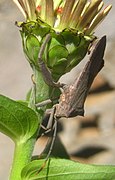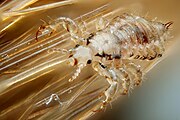Insect
| Insect Temporal range:
| |
|---|---|
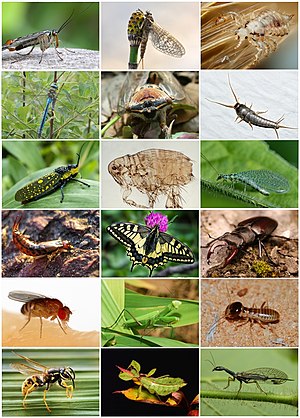 | |
| A wide diversity of insects from various orders. Insects have a three-part body: head with large compound eyes and antennae, a thorax with three pairs of legs and often wings, and a segmented abdomen. | |
| Scientific classification | |
| Domain: | Eukaryota |
| Kingdom: | Animalia |
| Phylum: | Arthropoda |
| Clade: | Pancrustacea |
| Subphylum: | Hexapoda |
| Class: | Insecta Linnaeus, 1758 |
| Subgroups | |
| Synonyms | |
| |
Insects (from
The insect
Nearly all insects hatch from eggs. Insect growth is constrained by the inelastic exoskeleton, so development involves a series of molts. The immature stages often differ from the adults in structure, habit and habitat. Groups that undergo four-stage metamorphosis often have a nearly immobile pupa. Insects that undergo three-stage metamorphosis lack a pupa, developing through a series of increasingly adult-like nymphal stages. The higher level relationship of the insects is unclear. Fossilized insects of enormous size have been found from the Paleozoic Era, including giant dragonfly-like insects with wingspans of 55 to 70 cm (22 to 28 in). The most diverse insect groups appear to have coevolved with flowering plants.
Adult insects typically move about by walking and flying; some can swim. Insects are the only invertebrates that can achieve sustained powered flight; insect flight evolved just once. Many insects are at least partly aquatic, and have larvae with gills; in some species, the adults too are aquatic. Some species, such as water striders, can walk on the surface of water. Insects are mostly solitary, but some, such as bees, ants and termites, are social and live in large, well-organized colonies. Others, such as earwigs, provide maternal care, guarding their eggs and young. Insects can communicate with each other in a variety of ways. Male moths can sense the pheromones of female moths over great distances. Other species communicate with sounds: crickets stridulate, or rub their wings together, to attract a mate and repel other males. Lampyrid beetles communicate with light.
Humans regard many insects as
Etymology
The word insect comes from the
Insects and other bugs
Distinguishing features
In common speech, insects and other terrestrial
- Insects and other bugs that could be confused with them
-
Insect: Six legs, three-part body
(head, thorax, abdomen),
up to two pairs of wings -
Spider: eight legs,
two-part body -
Woodlouse: seven pairs of legs, seven body segments (plus head and tail)
-
Centipede: many legs,
one pair per segment -
Millipede: many legs,
two pairs per segment
Diversity

Estimates of the total number of insect species vary considerably, suggesting that there are perhaps some 5.5 million insect species in existence, of which about one million have been described and named.[9] These constitute around half of all eukaryote species, including animals, plants, and fungi.[10] The most diverse insect orders are the Hemiptera (true bugs), Lepidoptera (butterflies and moths), Diptera (true flies), Hymenoptera (wasps, ants, and bees), and Coleoptera (beetles), each with more than 100,000 described species.[9]
- Insects are extremely diverse. Five groups each have over 100,000 described species.
-
True bugs
(Hemiptera) -
Butterflies and moths
(Lepidoptera) -
Flies
(Diptera) -
Wasps
(Hymenoptera) -
Beetles
(Coleoptera)
Distribution and habitats
- Insects occur in habitats as varied as snow, freshwater, the tropics, desert, and even the sea.
-
The snow scorpionfly Boreus hyemalis on snow
-
The great diving beetleDytiscus marginalislarva in a pond
-
The green orchid bee Euglossa dilemma of Central America
-
The desert locustSchistocerca gregarialaying eggs in sand
-
Sea skater Halobates on a Hawaii beach
Insects are distributed over every continent and almost every terrestrial habitat. There are many more species in the tropics, especially in rainforests, than in temperate zones.[11] The world's regions have received widely differing amounts of attention from entomologists. The British Isles have been thoroughly surveyed, so that Gullan and Cranston 2014 state that the total of around 22,500 species is probably within 5% of the actual number there; they comment that Canada's list of 30,000 described species is surely over half of the actual total. They add that the 3000 species of the American Arctic must be broadly accurate. In contrast, a large majority of the insect species of the tropics and the southern hemisphere are probably undescribed.[11] Some 30–40,000 species inhabit freshwater; very few insects, perhaps a hundred species, are marine.[12] Insects such as snow scorpionflies flourish in cold habitats including the Arctic and at high altitude.[13] Insects such as desert locusts, ants, beetles, and termites are adapted to some of the hottest and driest environments on earth, such as the Sonoran Desert.[14]
Phylogeny and evolution
External phylogeny
Insects form a
Internal phylogeny
The internal phylogeny is based on the works of Wipfler et al. 2019 for the Polyneoptera,[17] Johnson et al. 2018 for the Paraneoptera,[18] and Kjer et al. 2016 for the Holometabola.[19] The numbers of described extant species (boldface for groups with over 100,000 species) are from Stork 2018.[9]
| Insecta |
| ||||||||||||||||||||||||||||||||||||||||||||||||||||||||||||||||||||||||||||||||||||||||||||||||||||||||||||||||||||||||||||||||||||||||||||||||
Taxonomy
Early
Diagram of Linnaeus's key to his seven orders of insect, 1758[20]
| |||||||||||||||||||||||||||||||||||||||
In 1758, in his Systema Naturae,[22] Carl Linnaeus divided the animal kingdom into six classes including Insecta. He created seven orders of insect according to the structure of their wings. These were the wingless Aptera, the 2-winged Diptera, and five 4-winged orders: the Coleoptera with fully-hardened forewings; the Hemiptera with partly-hardened forewings; the Lepidoptera with scaly wings; the Neuroptera with membranous wings but no sting; and the Hymenoptera, with membranous wings and a sting.[20]
Modern
Traditional morphology-based
The use of phylogenetic data has brought about numerous changes in relationships above the level of
The Pterygota (
Evolutionary history
The oldest fossil that may be a primitive wingless insect is
Four large-scale radiations of insects have occurred: beetles (from about 300 million years ago), flies (from about 250 million years ago), moths and wasps (both from about 150 million years ago).[36]
The remarkably successful
-
The giant dragonfly-like insectMeganeura monyi grew to wingspans of 75 cm (2 ft 6 in) in the late Carboniferous, around 300 million years ago.[39]
Morphology and physiology
External
Three-part body
Insects have a
Segmentation
The head is enclosed in a hard, heavily
Exoskeleton
The outer skeleton, the
Internal systems
Nervous
The
Digestive
An insect uses its digestive system to extract nutrients and other substances from the food it consumes.
Reproductive
The
For males, the reproductive system consists of one or two
Respiratory
Circulatory
Because oxygen is delivered directly to tissues via tracheoles, the circulatory system is not used to carry oxygen, and is therefore greatly reduced. The insect circulatory system is open; it has no
Sensory

Many insects possess numerous specialized
Most insects, except some
The individual lenses in compound eyes are immobile, but fruit flies have photoreceptor cells underneath each lens which move rapidly in and out of focus, in a series of movements called photoreceptor microsaccades. This gives them, and possibly many other insects, a much clearer image of the world than previously assumed.[72]
An insect's sense of smell is via chemical receptors, usually on the antennae and the mouthparts. These detect both airborne volatile compounds and odorants on surfaces, including pheromones from other insects and compounds released by food plants. Insects use olfaction to locate mating partners, food, and places to lay eggs, and to avoid predators. It is thus an extremely important sense, enabling insects to discriminate between thousands of volatile compounds.[73]
Some insects are capable of magnetoreception; ants and bees navigate using it both locally (near their nests) and when migrating.[74] The Brazilian stingless bee detects magnetic fields using the hair-like sensilla on its antennae.[75][76]
Reproduction and development
Life-cycles
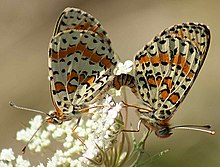
The majority of insects hatch from

Other developmental and reproductive variations include
Some insects are
Metamorphosis
Metamorphosis in insects is the process of development that converts young to adults. There are two forms of metamorphosis: incomplete and complete.
Incomplete

Complete

Communication
Insects that produce sound can generally hear it. Most
Light production
A few insects, such as
Sound production
Insects make sounds mostly by mechanical action of appendages. In
Very low sounds are produced in various species of
Communication using surface-borne vibrational signals is more widespread among insects because of size constraints in producing air-borne sounds.
Some species use vibrations for communicating, such as to attract mates as in the songs of the
Chemical communication

Many insects have evolved
Social behavior
Only insects that live in nests or colonies possess fine-scale spatial orientation. Some can navigate unerringly to a single hole a few millimeters in diameter among thousands of similar holes, after a trip of several kilometers. In philopatry, insects that hibernate are able to recall a specific location up to a year after last viewing the area of interest.[113] A few insects seasonally migrate large distances between different geographic regions, as in the continent-wide monarch butterfly migration.[114]
Care of young
Locomotion
Flight
Insects are the only group of
The evolution of insect wings has been a subject of debate; it has been suggested they came from modified gills, flaps on the spiracles, or an appendage, the epicoxa, at the base of the legs.[121] More recently, entomologists have favored evolution of wings from lobes of the notum, of the pleuron, or more likely both.[122] In the Carboniferous age, the dragonfly-like Meganeura had as much as a 50 cm (20 in) wide wingspan. The appearance of gigantic insects is consistent with high atmospheric oxygen at that time, as the respiratory system of insects constrains their size.[123] The largest flying insects today are much smaller, with the largest wingspan belonging to the white witch moth (Thysania agrippina), at approximately 28 cm (11 in).[124]
Unlike birds, small insects are swept along by the prevailing winds[125] although many larger insects migrate. Aphids are transported long distances by low-level jet streams.[126]
Walking
Many adult insects use six legs for walking, with an alternating
Swimming
A large number of insects live either part or the whole of their lives underwater. In many of the more primitive orders of insect, the immature stages are aquatic. In some groups, such as water beetles, the adults too are aquatic.[62]
Many of these species are adapted for under-water locomotion. Water beetles and water bugs have legs adapted into paddle-like structures. Dragonfly
Ecology
Insects play many critical roles in ecosystems, including soil turning and aeration, dung burial, pest control, pollination and wildlife nutrition.[133] For instance, termites modify the environment around their nests, encouraging grass growth;[134] many beetles are scavengers; dung beetles recycle biological materials into forms useful to other organisms.[135][136] Insects are responsible for much of the process by which topsoil is created.[137]
Defense

Insects are mostly small, soft bodied, and fragile compared to larger lifeforms. The immature stages are small, move slowly or are immobile, and so all stages are exposed to predation and parasitism. Insects accordingly employ multiple defensive strategies, including camouflage, mimicry, toxicity and active defense.[138] Many
Pollination
Pollination is the process by which pollen is transferred in the reproduction of plants, thereby enabling fertilisation and sexual reproduction.[144] Most flowering plants require an animal to do the transportation. The majority of pollination is by insects.[145] Because insects usually receive benefit for the pollination in the form of energy rich nectar it is a mutualism. The various flower traits, such as bright colors and pheromones that coevolved with their pollinators, have been called pollination syndromes, though around one third of flowers cannot be assigned to a single syndrome.[146]
Parasitism
Many insects are
-
Plant parasite ormicropredator: a coreidbug sucking plant sap
-
Human head-lice are directly transmitted obligateectoparasites.
Relationship to humans
As pests

Many insects are considered
In beneficial roles
Insects produce useful substances such as
Insects that feed on or parasitise other insects are beneficial to humans if they thereby reduce damage to agriculture and human structures. For example,
Fly larvae (maggots) were formerly used to treat wounds to prevent or stop gangrene, as they would only consume dead flesh. This treatment is finding modern usage in some hospitals. Insects have gained attention as potential sources of drugs and other medicinal substances.[176] Adult insects, such as crickets and insect larvae of various kinds, are commonly used as fishing bait.[177]
Population declines
At least 66 insect species extinctions have been recorded since 1500, many of them on oceanic islands.[178] Declines in insect abundance have been attributed to human activity in the form of artificial lighting,[179] land use changes such as urbanization or farming,[180][181] pesticide use,[182] and invasive species.[183][184] A 2019 research review suggested that a large proportion of insect species is threatened with extinction in the 21st century,[185] though the details have been disputed.[186] A larger 2020 meta-study, analyzing data from 166 long-term surveys, suggested that populations of terrestrial insects are indeed decreasing rapidly, by about 9% per decade.[187][188]
In research

Insects play important roles in biological research. For example, because of its small size, short generation time and high
As food

Insects are consumed as food in 80% of the world's nations, by people in roughly 3000 ethnic groups.
In other products
In religion and folklore

See also
- Entomology
- Ethnoentomology
- Flying and gliding animals
- Insect-borne diseases
Notes
- pillbugs).[6]
References
- ^ Lewis, Charlton T.; Short, Charles (1879). "insĕco". A Latin Dictionary. Perseus Digital Library.
- ^ Liddell, Henry George; Scott, Robert (1940). "ἔντομος". A Greek-English Lexicon. Perseus Digital Library.
- ^ Harper, Douglas; McCormack, Dan (November 2001). "Online Etymological Dictionary". LogoBee.com. p. 1. Archived from the original on 11 January 2012. Retrieved 1 November 2011.
- ^ "insect translations". ezglot.com.
- ^ "What is a bug? Insects, arachnids, and myriapods" at Museum of New Zealand Te Papa Tongarewa website. Accessed 10 March 2022.
- ^ ISBN 9781578590490.
- ISBN 978-0-00-219918-6.
- ^ a b c Gullan & Cranston 2005, pp. 22–48.
- ^ S2CID 23755007.
- ^ Erwin, Terry L. (1982). "Tropical forests: their richness in Coleoptera and other arthropod species" (PDF). The Coleopterists Bulletin. 36: 74–75. Archived (PDF) from the original on 23 September 2015. Retrieved 16 September 2018.
- ^ a b Gullan & Cranston 2014, p. 8.
- ^ Crook, Glynis. "Marine insects: small but significant". Deutsche Welle. Retrieved 2 December 2023.
- (PDF) from the original on 22 September 2017.
- ^ "Invertebrates: A Vertebrate Looks at Arthropods". Arizona-Sonora Desert Museum. Retrieved 21 May 2013.
- from the original on 18 October 2009. Retrieved 17 October 2009.
- PMID 27558853.
- PMID 30642969.
- PMID 30478043.
- PMID 27558853.
- ^ JSTOR 1220406.
- ISBN 978-1-4088-3622-4.
- ^ Linnaeus, Carl (1758). Systema naturae per regna tria naturae :secundum classes, ordines, genera, species, cum characteribus, differentiis, synonymis, locis (in Latin) (10th ed.). Holmiae (Laurentii Salvii). Archived from the original on 10 October 2008. Retrieved 22 September 2008.
- ISBN 978-0-674-06167-5.
- ISBN 978-2-88074-264-5.
- ^ ISBN 978-0-226-84548-7.
- ^ Haeckel, Ernst (1874). Anthropogenie oder Entwickelungsgeschichte des menschen (in German). W. Engelmann. p. 202.
- ^ Gullan & Cranston 2005, p. 180.
- ^ a b Kendall, David A. (2009). "Classification of Bugs". Archived from the original on 20 May 2009. Retrieved 9 May 2009.
- S2CID 85309726.
- PMID 15315891.
- S2CID 86259809.
- S2CID 14059547.
- S2CID 56100681.
- S2CID 251464185.
- ISSN 0024-4066.
- PMID 21402926.
- ^ Carter, J. Stein (29 March 2005). "Coevolution and Pollination". University of Cincinnati. Archived from the original on 30 April 2009. Retrieved 9 May 2009.
- ^ "Coevolution and Pollination". University of Cincinnati. Archived from the original on 30 April 2009. Retrieved 9 May 2009.
- ISBN 978-0674025745.
- ^ a b c Resh & Carde 2009, p. 13.
- ^ Gullan & Cranston 2005, p. 22–24.
- PMID 31438822.
- S2CID 258209514.
- ^ Gullan & Cranston 2005, p. 57.
- from the original on 25 June 2009. Retrieved 22 May 2009.
- PMID 17803459.
- ^ "General Entomology – Digestive and Excritory system". NC state University. Archived from the original on 23 May 2009. Retrieved 3 May 2009.
- PMID 24224520.
- ^ Gullan & Cranston 2005, pp. 70–77.
- ^ "General Entomology – Digestive and Excretory system". North Carolina State University. Archived from the original on 23 May 2009. Retrieved 3 May 2009.
- ^ Duncan, Carl D. (1939). A Contribution to The Biology of North American Vespine Wasps (1st ed.). Stanford: Stanford University Press. pp. 24–29.
- ^ Nation 2001, p. 31.
- ^ Gullan & Cranston 2005, p. 70.
- ^ Nation 2001, p. 30–31.
- ^ Nation 2001, p. 32.
- ^ Gullan & Cranston 2005, pp. 71–72, 78–80.
- ^ Resh, Carde & 2009, p. 880.
- ^ Resh & Carde 2009, p. 885.
- ^ "What Keeps Bugs from Being Bigger?". Argonne National Laboratory. 8 August 2007. Archived from the original on 14 May 2017. Retrieved 15 July 2013.
- ^ Gullan & Cranston 2005, pp. 65–68.
- ISBN 978-0-19-851549-4.
- ^ ISBN 978-0-7575-5049-2.
- ISBN 978-0-7575-4128-5.
- ^ Gullan & Cranston 2005, pp. 61–65.
- ^ Meyer, John R. (17 February 2006). "Circulatory System". NC State University: Department of Entomology, NC State University. p. 1. Archived from the original on 27 September 2009. Retrieved 11 October 2009.
- OCLC 55793895.
- ^ Gullan & Cranston 2014, pp. 95–124.
- ^ "Insects" (PDF). Alien Life Forms. p. 4. Archived (PDF) from the original on 8 July 2011. Retrieved 17 May 2009.
- ^ Gullan & Cranston 2014, pp. 97–103.
- .
- S2CID 20894534.
- PMID 35298337.
- PMID 26416146.
- PMID 20106876.
- S2CID 10746883.
- S2CID 10162385.
- PMID 23782888.
- ^ a b "insect physiology" McGraw-Hill Encyclopedia of Science and Technology, Ch. 9, p. 233, 2007
- ^ Gullan & Cranston 2005, pp. 129, 131, 134–135.
- ^ Gullan & Cranston 2005, pp. 136–137.
- ^ "Glossary of Lepidopteran and Odonate anatomy". Rare species atlas. Virginia Department of Conservation and Recreation. 2013. Archived from the original on 4 October 2013. Retrieved 14 June 2013.
- ^ a b Gullan & Cranston 2005, p. 143.
- ISBN 978-0-8050-6331-8.
- S2CID 20388889.
- S2CID 25758038.
- S2CID 1941852. Archived from the original(PDF) on 9 September 2010.
- ^ Gullan & Cranston 2005, p. 142.
- ISBN 978-0-03-025982-1.
- ^ Gullan & Cranston 2005, p. 151.
- PMID 19131593.
- ^ Gullan & Cranston 2005, pp. 87–94.
- doi:10.1080/00779962.1983.9722435. Archived from the original(PDF) on 20 October 2007.
- S2CID 86502129.
- ISBN 978-0-12-586990-4.
- ^ "The University of Florida Book of Insect Records". entnemdept.ufl.edu. Department of Entomology & Nematology, UF/IFAS. Retrieved 13 January 2022.
- .
- .
- S2CID 18306198.
- PMID 17517637.
- S2CID 206520028.
- S2CID 10338592.
- .
- PMC 1692226.
- S2CID 11369425.
- S2CID 35812411.
- S2CID 9637568.
- S2CID 45597312.
- ^ a b Gullan & Cranston 2005, pp. 96–105.
- PMID 33861721.
- ^ Brewer, Gary. "Social insects". North Dakota State University. Archived from the original on 21 March 2008. Retrieved 6 May 2009.
- ^ Gullan & Cranston 2005, pp. 309–311.
- S2CID 569654.
- .
- ^ Gullan & Cranston 2005, p. 14.
- ^ "Social Insects". North Dakota State University. Archived from the original on 21 March 2008. Retrieved 12 October 2009.
- ISBN 978-0-642-56850-2. Archived from the originalon 30 November 2012.
- PMID 14327957.
- S2CID 17453426.
- .
- .
- PMID 15388766.
- ISBN 9780691243115.
- (PDF) from the original on 24 January 2013. Retrieved 8 December 2012.
- ^ "Chapter 32: Largest Lepidopteran Wing Span | The University of Florida Book of Insect Records | Department of Entomology & Nematology | UF/IFAS". entnemdept.ufl.edu. Retrieved 13 January 2022.
- ^ Yates, Diana. "Birds migrate together at night in dispersed flocks, new study indicates". news.illinois.edu. Retrieved 13 January 2022.
- .
- ISBN 978-0-19-850022-3.[page needed]
- PMID 22972892.
- S2CID 85017400.
- S2CID 45066664.
- S2CID 40832917.
- doi:10.1146/annurev.fluid.38.050304.092157. Archived from the original(PDF) on 10 July 2007.
- ^ Schowalter 2006, pp. 3, 572.
- ^ Gullan & Cranston 2014, p. 257.
- ^ Gullan & Cranston 2014, pp. 261–264.
- from the original on 12 January 2012. Retrieved 8 November 2011.
- ^ Gullan & Cranston 2005, pp. 3, 218–228.
- ^ ISBN 978-0-520-22323-3.
- ^ "Photos: Masters of Disguise – Amazing Insect Camouflage". 24 March 2014. Archived from the original on 12 June 2015. Retrieved 11 June 2015.
- .
- S2CID 28667520.
Viceroys are as unpalatable as monarchs, and significantly more unpalatable than queens from representative Florida populations.
- PMID 17048984.
- ISBN 978-0-691-00974-2.
- ^ Wigglesworth, Vincent Brian. "Insect". Encyclopædia Britannica online. Archived from the original on 4 May 2012. Retrieved 19 April 2012.
- ^ "Pollinator Factsheet" (PDF). United States Forest Service. Archived from the original (PDF) on 10 April 2008. Retrieved 19 April 2012.
- PMID 19218577.
- ^ S2CID 257756440.
- PMID 30001194.
- S2CID 219039881.
- S2CID 23457678.
- PMID 21295676.
- ^ PMID 24229807.

- ISBN 978-1-118-84616-2.
- .
- S2CID 84996305.
- PMID 17827110.
- ISBN 978-0-8165-2544-7.
- PMID 8080506.
- PMID 12946395.
- PMID 21212153.)
{{cite journal}}: CS1 maint: numeric names: authors list (link - PMID 19713499.
- ISBN 978-0-674-48525-9.
- S2CID 231710967.
- .
- .
- ^ "Wax Rendering". Bee Culture. 23 March 2016. Retrieved 26 October 2018.
- ^ "How Shellac Is Manufactured". The Mail (Adelaide, SA : 1912 – 1954). 18 December 1937. Retrieved 17 July 2015.
- ^ Bezzina, Neville. "Silk Production Process". Sense of Nature Research. Archived from the original on 29 June 2012.
- S2CID 4177275.
- PMID 26560301.
- ISBN 0813534461.
- S2CID 18008906.
- ^ Gullan & Cranston 2005, p. 328–348, 400.
- ^ "Biocontrol Network – Beneficial Insects". Biocontrol Network. Archived from the original on 28 February 2009. Retrieved 9 May 2009.
- ISBN 978-0-471-86314-4.
- PMID 20957283.
- S2CID 44543735.
- .
- PMID 30519447.
- S2CID 54532666.
- ISBN 978-0-12-803324-1.
- S2CID 51625489.
- PMID 19743915.
- ^ Wilson, E. O. "Threats to Global Diversity". Archived from the original on 20 February 2015. Retrieved 17 May 2009.
- .
- ^ Saunders, Manu (16 February 2019). "Insectageddon is a great story. But what are the facts?". Ecology is not a dirty word. Archived from the original on 25 February 2019. Retrieved 24 February 2019.
- S2CID 216106896
- ^ McGrath, Matt (23 April 2020). "'Insect apocalypse' more complex than thought". BBC News. Retrieved 24 April 2020.
- ISBN 978-0-7167-8881-2.
- PMID 10731132.
- . Retrieved 3 December 2021.
- ^ "Insects could be the key to meeting food needs of growing global population". the Guardian. 31 July 2010. Retrieved 13 January 2022.
- ISBN 978-0-89281-747-4. Retrieved 23 April 2014.
- ^ a b "Insects as Food for Humans". Retrieved 14 September 2022.
- ^ Gullan & Cranston 2005, pp. 10–13.
- ^ Michels, John (1880). John Michels (ed.). Science. Vol. 1. New York: American Association for the Advance of Science. p. 69.
- ^ Maierbrugger, Arno (14 May 2013). "UN: Insects are 'food of the future' (video)". Inside Investor. Archived from the original on 10 September 2013. Retrieved 17 May 2013.
- PMID 30052193.
- ^ "From Pest to Pot: Can Insects Feed the World?". National Geographic Culture. 15 August 2016. Archived from the original on 10 April 2021. Retrieved 13 January 2022.
- ^ "How AgriProtein makes chicken food from maggots". Wired UK. Retrieved 13 January 2022.
- ^ Bugs. "Bugs – das Wirbellosenmagazin". NTV Verlag. Retrieved 7 March 2021.
- ^ Gullan & Cranston 2005, p. 9.
Sources
- Gullan, P. J.; Cranston, P. S. (2005). The Insects: An Outline of Entomology (3rd ed.). Oxford: Blackwell Publishing. ISBN 978-1-4051-1113-3.
- Gullan, P. J.; Cranston, P. S. (2014). The Insects: An Outline of Entomology (5th ed.). Oxford: Wiley Blackwell. ISBN 978-1-118-84616-2.
- Nation, James L. (2001). Insect Physiology and Biochemistry (1st ed.). CRC Press. ISBN 978-0-8493-1181-9.
- Resh, Vincent H.; Carde, Ring T. (2009). Encyclopedia of Insects (2 ed.). Academic Press. ISBN 978-0-12-374144-8.
- Schowalter, Timothy Duane (2006). Insect Ecology: An Ecosystem Epproach (2nd (illustrated) ed.). Academic Press. ISBN 978-0-12-088772-9. Archivedfrom the original on 3 June 2016. Retrieved 27 October 2015.
External links
- Insect species and observations on iNaturalist
- Overview of Orders of Insects
- "Insect" at the Encyclopedia of Life
- A Safrinet Manual for Entomology and Arachnology SPC
- Tree of Life Project – Insecta, Insecta Movies
- Fossil Insect Database: Holotypes at the International Palaeoentological Society
- UF Book of Insect Records
- InsectImages.org 24,000 high resolution insect photographs








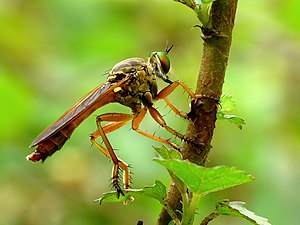













![The giant dragonfly-like insect Meganeura monyi grew to wingspans of 75 cm (2 ft 6 in) in the late Carboniferous, around 300 million years ago.[39]](http://upload.wikimedia.org/wikipedia/commons/thumb/e/ed/Meganeura_monyi_au_Museum_de_Toulouse.jpg/430px-Meganeura_monyi_au_Museum_de_Toulouse.jpg)



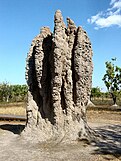

![A parasitoid wasp ovipositing into an aphid[155]](http://upload.wikimedia.org/wikipedia/commons/thumb/0/04/CSIRO_ScienceImage_2357_Spotted_alfalfa_aphid_being_attacked_by_parasitic_wasp.jpg/180px-CSIRO_ScienceImage_2357_Spotted_alfalfa_aphid_being_attacked_by_parasitic_wasp.jpg)
